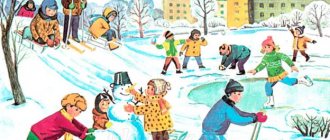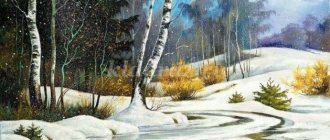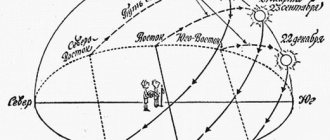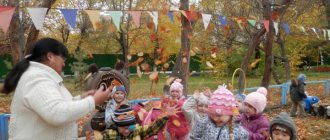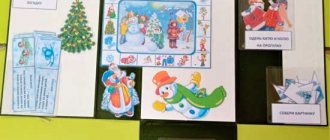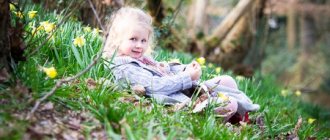Summary of a winter walk in kindergarten in the middle group “Winter-Winter”
Summary of a walk for children 4-5 years old “Winter-Winter”
Purpose: to consolidate knowledge about natural phenomena. Objectives: Continue to form children’s ideas about the properties of snow; To cultivate a love for nature and respect for it; Develop the ability to logically answer questions posed and prove your point; attention, memory. Instill hard work and a desire to help others. Type: integrated. Children's age: 4-5 years. Forms of educational activities: group, individual. Educational area: “Cognitive development” Integration of educational areas: “Speech development”, “Cognitive development”, “Physical development”, “Social and communicative development”. Preliminary work: reading poetry, asking riddles, looking at plot paintings about winter. Equipment and materials: shovels for clearing snow on the site, a box, molds, sleds, cheesecakes, squares, triangles and circles, a letter from Zimushka - Winters, a ball, a small artificial Christmas tree, ice cubes, scoops, plastic buckets, sleds for dolls, dolls, blocks (6cm)
Progress of the walk
Teacher: Guys, the postman gave you a letter. Who is this letter from? (reads the address: Apraksino village, kindergarten “Alyonushka”, middle group. From Zimushka-Zima). Let's open it and read, what interesting thing did she write to us? “Hello, dear guys! I would really like to know what you know about me, about Zimushka-Winter. For this, I have prepared tasks for you, and if you can cope with them, it will make me happy.” Educator: children, Zimushka-Winter asks you to determine what the weather is like today? (Children's answers) Teacher: wonderful, the sun is shining, there is no wind. What time of year is it now? (Children's answers) Educator: winter. What time of year was it before winter? (Children's answers) Educator: autumn. What month are we in now? (Children's answers) Educator: February, listen to the proverb about February and think about what it could mean? “Blizzards and blizzards flew away in February.” Educator: In February there are the most snowstorms. Why is winter the coldest season of the year? (Children's answers) Educator: You are all great! I think Zimushka - Winter is pleased with your answers! 1. Observation Teacher: children, now listen to the poem: Where do snowflakes come from? Who knits snowflakes and throws them from the sky? Even my mother doesn’t know these patterns and I’ve never seen yarn like this anywhere - Our village is all white, slightly blue. Or maybe they are cut out of chintz and quietly lowered onto my eyelashes? They slowly melt like tears on your cheeks... Where do snowflakes come from? Does anyone know? Educator: What time of year do you think this poem is talking about? (Children's answers) Educator: That's right, guys, about winter. A wonderful poem, isn't it? Tell me please, what is spinning smoothly in the air? (Children's answers) Educator: guys, let's look carefully at the white snowflakes, how they spin and slowly fall to the ground. I suggest you stretch your arms forward and see whose mitten the most snowflakes will fall on! Experience with snow . A snowflake fell onto my palm, I will warm it with my breath a little. Snowflake, have you decided to play hide and seek? I can’t see you on my palm. Educator: what do you think, if a snowflake falls on your palm, what will happen? (Children catch snowflakes with their bare hands and make sure that the snowflakes melt quickly). (Children's answers) Conclusion.
Snowflakes melt because snow is water.
In winter it is cold, due to this frost and rain, they freeze and turn into snowflakes. How does snow feel? Can you touch it with your palm? (Children's answers) Educator: that's right, snow is cold for us. But it serves as a blanket for plants and soil. When there is a lot of snow, the plants and soil are warmer. 2. Outdoor game. Educator: and now I invite you to play our favorite game: “Fidget Sparrow.” Rules of the game: first you need to choose who will be the cat. A little counting rhyme will help us with this: Ahi, ahi, ahi, oh Masha sowed peas They were born thick We will rush, you wait! The cat leaves the playground and hides behind a bench.
Children perform the following movements: The fidgety sparrow jumps and spins, he is very happy that the puddle is frozen, they jump on two legs, they show off, they march bravely Only “Meow!”
he is afraid of. squat down and look around. The cat runs out of hiding, meows and begins to catch the running children. A caught sparrow becomes a cat. The game is repeated 2 - 3 times. Sedentary game. Educator : the next game is called: “Don’t wake the bear.” Rules of the game: children form a circle holding hands. They dance in a circle together with the teacher who pronounces the text. Like on the hill there is snow, snow, and under the hill there is snow, snow. (They turn in the opposite direction and dance in a circle.) And under the tree there is snow, snow, and on the tree there is snow, snow. (They go to the center of the circle.) And a bear sleeps under the tree. Hush hush! Don't wake me up, sit down, don't make noise! (They squat down.) Didactic game Teacher: And I want to play one more game with you. It’s called “It happens - it doesn’t happen.” Rules of the game: The teacher says phrases and throws the ball, and the children must answer quickly. Snow in winter... (happens) Frost in summer... (does not happen) Frost in summer... (does not happen) drops in summer... (does not happen) 3. Labor. Educator: Quiet - quiet, it’s snowing, White snow, shaggy, We will clear the snow and ice in the yard with a shovel. Guys, look, our area is all covered with snow, there is no free space at all. In order for us to quickly complete the work, we need to divide into several groups. And this wonderful bag will help us share; you take turns taking out one of the figures. How can you call all these figures in one word? (geometric). Guys who have triangles - unite, you will shovel the snow into small piles; whoever has a square will load snow onto a sled and transport it to the place where we will build, for example, a fortress; and those who have mugs will sweep the paths. In order to quickly get the job done and play in the cleared area, we need to work quickly and consistently. Everyone must do their job so that it does not have to be redone. Now, guys, grab the equipment you need and get to work. (During the work process, I direct the efforts of each child to achieve the goal. I pay special attention to children who find it difficult to complete the task. I teach the children to help each other with advice, showing, but not to do the work for another. In the process of joint work, I carefully look at relationships, which develop between children). 4. Individual work. Educator: Zhenya, Ilya and Ksenia, please come to me. There is no better recipe in the world - Be inseparable from sports, You will live a hundred years - That's the whole secret! Let's practice jumping over blocks (height 6 cm). Try to jump higher. Educator: Well done, you tried very hard. 5. Independent activity of children. Educator: and now, guys, I suggest you play on your own. Look how many toys we took with us. -Take what you like. -Katya, Taya, take Mouse and a spatula, dig a hole in the snow for the mouse. -Ivan, Yaroslav, take the hoop, put it on the ground and try to hit it with snowballs. -Lera, Nadya, take the molds and “bake” a snow pie. Reflection. Educator: now, it’s time for us to read again what winter writes to us. “Dear children, I love you all very much and thank you for your knowledge, you answered all the questions that interested me.” Educator: guys, did you like our walk? (Children's answers). What do you remember? (Children's answers). What would you like to repeat? (Children's answers)
We recommend watching:
Synopsis of a winter walk for children in the middle group Synopsis of a targeted winter walk in the middle group of kindergarten Synopsis of a walk in kindergarten in the middle group: Winter fun
Similar articles:
Observation “Footprints in the snow.” Middle group
Walk observation in winter in the middle group. Winter clothes
Summary of a winter walk in the middle group lesson plan (secondary group) on the topic
Walk in a middle groupChildren's age: 4-5 years.
Goal: Creating favorable conditions for the development of cognitive and motor activity of children during a walk
Objectives: - Continue to introduce children to the seasonal changes of nature.
— As part of the group project “Beauty Herringbone,” expand ideas about the structure and growing conditions of spruce and pine; explain the significance of trees, in particular spruce and pine, for humans, and draw children’s attention to the problem of protecting coniferous plantings, especially before the New Year.
— Continue to develop the ability to act on the teacher’s signal and coordinate your movements with the movements of peers in outdoor games; develop attention, auditory perception and curiosity; continue to develop the ability to jump on two legs.
— Cultivate interest in phenomena occurring in nature; to coniferous trees in the course of educational and research activities, to encourage children to directly communicate with nature. Foster positive attitudes towards joint activities and a healthy lifestyle.
- Vocabulary work: snow blanket, wrapped up, frosty air, spruce, pine, winter clothes.
Preliminary work with children: examination of the album “Seasons”; viewing slides of an educational thematic multimedia presentation about seasonal changes; examining spruce and pine trees on the territory of the preschool educational institution, learning poems about winter, Christmas trees and winter fun, learning outdoor games.
Equipment: dog mask, hoops, shovels, scoops, brooms, buckets, snow molds, sleds, snowballs.
Walking progress:
Introductory part:
Conducted in the locker room while children are dressing. The teacher draws attention to the need for warm clothing and reinforces with the children the names of clothes, shoes, and hats. Children go outside.
Main part:
Observation and conversation with children begins with an emotional moment.
Educator: Guys, look how beautiful it is outside! All around is white! And how good it is to breathe!
Then, together with the children, they remember the signs of winter, the properties of snow:
— What time of year is it now? (Winter)
- Do you like winter? (Children's statements)
— What do you like most in winter? (Children's answers)
- Let's inhale the winter, fresh, frosty air through the nose, and exhale through the mouth.
Listen to this beautiful poem:
White fluffy snow swirls in the air and quietly falls to the ground to lie down. And in the morning the Field turned white with snow, as if everything had covered it with a shroud.
— Did you like this poem?
Educator: Guys, do you want to see how our Green beauties are doing? Let's visit them. Children with a teacher approach the lawn where mature pine, spruce and spring pine plantings grow.
Guys, greet the Christmas trees, say kind words to them (Greeting children)
Study of spruce and pine needles.
— How is the Christmas tree different from other trees? (children's answers)
“My feelings” (after examining the trunk, pine branches)
Didactic word game:
“Who are pine and spruce friends with?”
The teacher reads I. Tokmakova’s poem “They ate at the edge of the forest, reaching the tops of their heads to heaven...”
Outdoor game “Snow is spinning”
Goal: depict how the snow is falling, coordinating actions with other children, without bumping into each other.
Progress of the game: children join hands and form a round dance. While moving in a circle, the teacher pronounces the text, encouraging the children to accompany the words with appropriate movements: the children move in a circle, stop and slowly spin to the right, then to the left, moving their hand, the children show how snow spreads along the roads, lies on the branches of trees, the children stop , movements show how they put on fur coats, put on boots, then stomp their feet, clap their hands, and jump up to keep warm in the cold.
White snowflakes have been swirling in the morning, Snowdrifts have grown in the middle of the yard. The street has become brighter from the snowflakes, We just need to dress warmer. It’s simply impossible not to love winter, Soon we will be sculpting something out of snow.
- Well done!
- Guys, guess the riddle!
The children cleverly sculpted me and made balls out of snow.
Instead of a nose there is a carrot, instead of eyes there are coals.
They put a bucket on his head and a straw wig.
Now tell me quickly. Who is this? (Snowman)
Independent (play, motor, constructive) activities of children.
Rolling snowballs.
Laying out a snowman, simple figures from lumps of snow. Using snowballs made by children the day before.
Children's independent games with outdoor toys.
Labor activity (subgroup)
Educator: Let's take shovels, clear the paths of snow, and use brooms to sweep the snow off the bench.
Goal: to practice labor skills and cultivate diligence.
Subgroup work on physical development “We continue to prepare for the Winter Olympics!”
The teacher invites the children to play in the snow. Let's take snowballs and try to get into the basket. (Children throw snowballs at a horizontal target)
- Well done! How clever you are!
Individual work with children on physical development
The teacher invites the children to practice:
- jump on two legs in place (2-3 children),
- jump on two legs moving forward (2-3 children),
- throwing a snowball over an obstacle (2-3 children).
